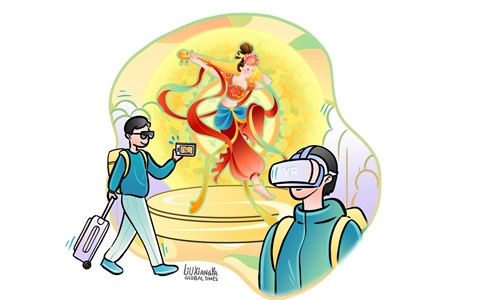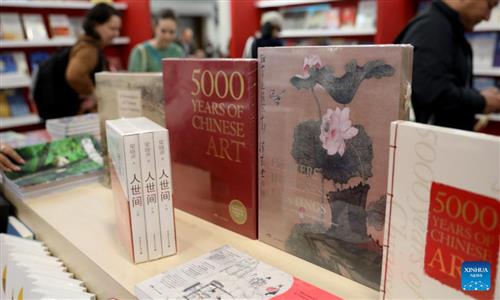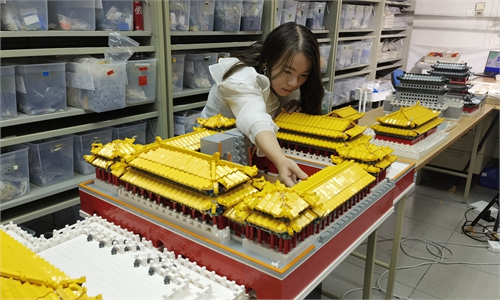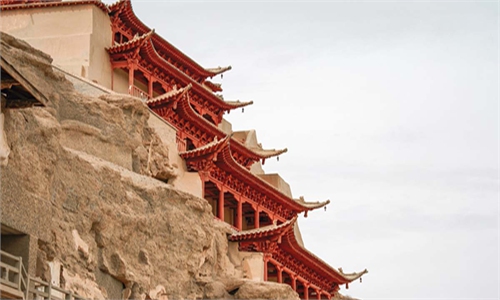ARTS / CULTURE & LEISURE
Immersion breathes new life into tourism

Illustration: Liu Xiangya/Global Times
Immersive cultural tourism has experienced a surge in popularity in recent years. This new form of experiential travel has tapped into the growing consumer demand for interactive and sensory-rich experiences, creating a fresh dynamic in the tourism industry. The success of immersive cultural tourism can be attributed to its ability to meet people's evolving expectations and its capacity to breathe new life into cultural heritage and narratives.
"Immersive" has become a buzzword in recent years, primarily due to the advancement of technologies such as the internet, big data and virtual reality. At its core, immersion refers to being deeply absorbed or engrossed in a particular environment or activity.
This concept has been applied in various contexts, encompassing two main forms: one involves constructing real or virtual environments that transport individuals into entirely new worlds, like walking onto a stage as real-life performances are going on, while others utilize online platforms such as livestreaming, videos, and augmented reality (AR) to immerse people in specific scenarios or events.
The explosive popularity of the immersive trend can be attributed to its inherent interactivity and experiential nature, which cater to the evolving desires of modern-day travelers. Superficial tourism or passive learning experiences have lost their glamour as tourists seek more accurate, deeper and more engaging participation and immersion. In response to this demand, immersive cultural performances, night tours and immersive exhibitions have sprung up, breathing life into cultural and educational experiences.
Immersive experiences integrate technology, intelligence and creativity. They recreate historical settings, depict fantastical dreamscapes, design experiential spaces for both old and new items, and create real-time interactive platforms. Immersion offers sensory experiences involving sight, sound, touch, and smell, as well as narrative and emotional experiences, along with the pursuit of values, making them multi-dimensional and all-encompassing experiences that affect both body and mind.
The immersive cultural tourism wave is transforming the essence of travel by offering deeper, more meaningful experiences. It goes beyond the traditional elements of "traveling, shopping and entertainment," and focuses on in-depth exploration and interactive leisure. Recent examples of immersive cultural tourism demonstrate its ability to enrich travel experiences.
In Xi'an, Northwest China's Shaanxi Province, the slogan "Xi'an during the day, Chang'an (the ancient name of Xi'an) at night," welcomes visitors to the Tang Dynasty Everbright City, a place that transports tourists to the splendors of the Tang Dynasty (618-907) at its prime. The interactive game Tang Dynasty Treasure Box has also gained immense popularity for its immersive nature.
In Yangzhou, East China's Jiangsu Province, the China Grand Canal Museum offers a lifelike experience, digitally showcasing the history and culture of the Grand Canal in its entirety. Visitors can explore the canal's history and culture from every angle, across all time periods, and from various perspectives.
In Pingyao, North China's Shanxi Province, a large-scale immersive theater production titled Revisiting Pingyao introduces a unique walk-through viewing experience. The audience is not confined to seats. Instead, they move along with the storyline, witnessing different scenes as the narrative unfolds, making them both spectators and participants in the story.
In Dunhuang, Northwest China's Gansu Province, a high-profile immersive cave performance Ancient Sound of Dunhuang offers visitors an opportunity to explore the mural paintings of the Mogao Caves in an immersive manner. Dubbed the "living No.736 cave of the Mogao Caves," it illustrates the story of ancient music through the use of traditional Chinese instruments, injecting new vitality into the city, especially in slack winter seasons.
By adopting immersive experiences, these attractions have unlocked the potential of cultural and tourism resources, reviving traditional culture in the modern era and presenting it in a fresh light.
In essence, tourism involves temporarily leaving one's usual place of residence and experiencing a change in one's surroundings and relationships. Immersive cultural tourism offers a much more enriching experience, reflecting the integration of culture and tourism.
From a content perspective, immersive cultural tourism caters to a wide range of cultural elements, including historical, revolutionary and ecological themes. These experiences allow tourists to immerse themselves in the past, present, and even the realm of their imagination.
From a technological perspective, immersive cultural tourism leverages innovations like 5G, ultra-high-definition screens, augmented and virtual reality, artificial intelligence and the metaverse. These experiences break free from traditional viewing methods, allowing visitors to walk through and immerse themselves in a storyline.
Immersive cultural tourism is transforming the way people travel by offering in-depth exploration, interactive experiences and meaningful learning opportunities. It elevates tourism from the superficial pursuit of sightseeing to a holistic engagement with culture and history. Additionally, it plays an irreplaceable role in promoting cultural heritage, sharing China's stories, enhancing cultural confidence, and fostering cultural development.
By offering interactive, sensory-rich experiences that transcend traditional tourism, it has brought new life to cultural heritage and narratives. As travel is no longer just about sightseeing but also about experiencing, learning and connecting with culture and history, immersive cultural tourism has found its place. It has not only enhanced the tourism experience but also contributed to cultural preservation and revitalization.
The author is a reporter with the Global Times. life@globaltimes.com.cn



